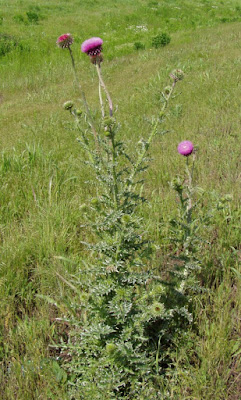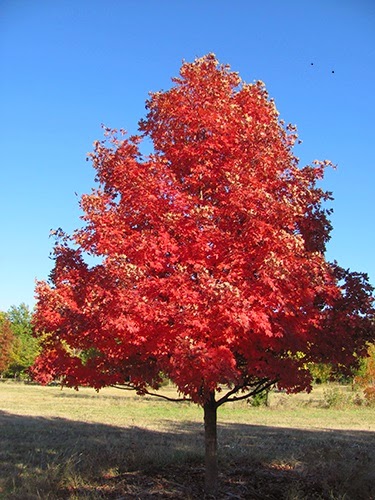Prickly Purple Flowers
Neil Cates, Livestock Agent
Are you fighting musk thistles this spring? Musk thistle is a major problem for many in our area. Musk thistle is on the list of noxious weeds in the state of Kansas. The Kansas Noxious Weed Law first enacted in 1937, requires landowners to control and eradicate weeds on lands they own or manage.
Knowing the musk thistle’s life cycle is important to getting a good control strategy in place. The musk thistle is primarily a biennial or winter-annual plant. As a biennial, the seeds will germinate in the spring and the plants will remain as rosettes during the entire growing season. Then, after surviving a winter, the plants will bolt, flower, and produce seeds, thus taking parts of two growing seasons to complete their life cycle. As a winter annual, musk thistle emerges in the late fall with moisture. The plants go through the winter, then produce seeds the following year.
Musk thistle only reproduces by seed. Therefore, the goal of any control program is to reduce and/or eliminate seed production. Control options include mechanical, biological, cultural, and chemical methods.
Cultural control practices, including prescribed burning and good grazing management, can help keep musk thistle populations at lower levels. Burning by itself will not kill musk thistle, but it can remove the excessive amounts of litter that prevent good coverage when spraying. Plus, proper burning can stimulate warm-season grasses that compete against musk thistle. Spraying areas with musk thistle should follow about 10 to 14 days after burning. We’ve obviously missed the window for burning this year, but something to keep in mind for next year. Proper grazing that maintains and improves the vigor of competing vegetation can also help keep musk thistle populations down.
Musk thistle plants are most easily controlled by herbicides applied during the seedling and rosette stages of growth. Common herbicides such as 2,4-D, dicamba, and picloram are very effective on rosettes. Products containing metsulfuron, chlorsulfuron, and aminopyralid are also effective on musk thistle.
Once plants begin to bolt, products such as picloram +2,4-D (Tordon 22K + 2,4-D), metsulfuron + 2,4-D (Escort XP + 2,4-D), metsufuron + chlorsulfuron (Cimarron Plus), metsulfuron + dicamba + 2,4-D (Cimarron Max), or aminopyralid alone (Milestone) or in combination with 2,4-D (ForeFront HL) are more effective.
Musk thistles need to be treated before they start to bloom for effective control. Although some herbicides, such as metsulfuron, have proven to reduce seed viability when applied at the bloom stage, they are unlikely to eliminate all seed production. It only takes one seed to keep the population going.
Always read the herbicide label before using and pay attention to precautionary statements, grazing or haying restrictions and application rates. Herbicide recommendations for musk thistle are available in the “2016 Chemical Weed Control for Field Crops, Pastures, Rangeland, and Noncropland” publication available at your local extension office free of charge. Happy spraying!
Are you fighting musk thistles this spring? Musk thistle is a major problem for many in our area. Musk thistle is on the list of noxious weeds in the state of Kansas. The Kansas Noxious Weed Law first enacted in 1937, requires landowners to control and eradicate weeds on lands they own or manage.
Knowing the musk thistle’s life cycle is important to getting a good control strategy in place. The musk thistle is primarily a biennial or winter-annual plant. As a biennial, the seeds will germinate in the spring and the plants will remain as rosettes during the entire growing season. Then, after surviving a winter, the plants will bolt, flower, and produce seeds, thus taking parts of two growing seasons to complete their life cycle. As a winter annual, musk thistle emerges in the late fall with moisture. The plants go through the winter, then produce seeds the following year.
Musk thistle only reproduces by seed. Therefore, the goal of any control program is to reduce and/or eliminate seed production. Control options include mechanical, biological, cultural, and chemical methods.
Cultural control practices, including prescribed burning and good grazing management, can help keep musk thistle populations at lower levels. Burning by itself will not kill musk thistle, but it can remove the excessive amounts of litter that prevent good coverage when spraying. Plus, proper burning can stimulate warm-season grasses that compete against musk thistle. Spraying areas with musk thistle should follow about 10 to 14 days after burning. We’ve obviously missed the window for burning this year, but something to keep in mind for next year. Proper grazing that maintains and improves the vigor of competing vegetation can also help keep musk thistle populations down.
Musk thistle plants are most easily controlled by herbicides applied during the seedling and rosette stages of growth. Common herbicides such as 2,4-D, dicamba, and picloram are very effective on rosettes. Products containing metsulfuron, chlorsulfuron, and aminopyralid are also effective on musk thistle.
Once plants begin to bolt, products such as picloram +2,4-D (Tordon 22K + 2,4-D), metsulfuron + 2,4-D (Escort XP + 2,4-D), metsufuron + chlorsulfuron (Cimarron Plus), metsulfuron + dicamba + 2,4-D (Cimarron Max), or aminopyralid alone (Milestone) or in combination with 2,4-D (ForeFront HL) are more effective.
Musk thistles need to be treated before they start to bloom for effective control. Although some herbicides, such as metsulfuron, have proven to reduce seed viability when applied at the bloom stage, they are unlikely to eliminate all seed production. It only takes one seed to keep the population going.
Always read the herbicide label before using and pay attention to precautionary statements, grazing or haying restrictions and application rates. Herbicide recommendations for musk thistle are available in the “2016 Chemical Weed Control for Field Crops, Pastures, Rangeland, and Noncropland” publication available at your local extension office free of charge. Happy spraying!








